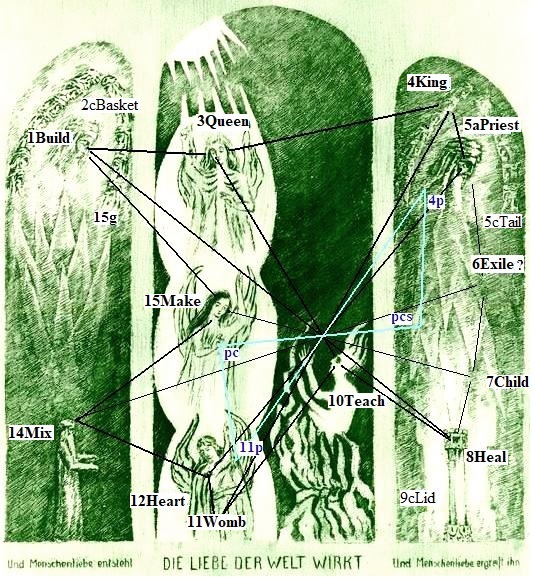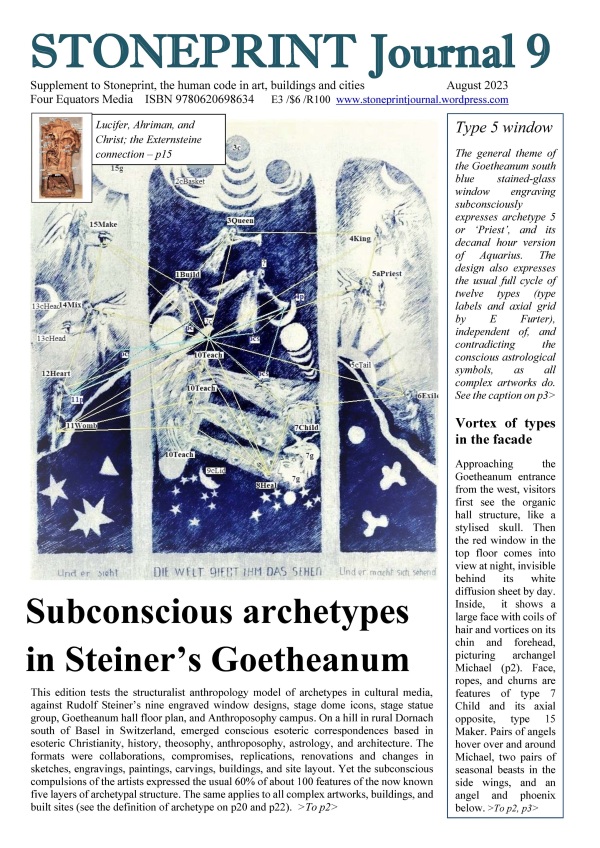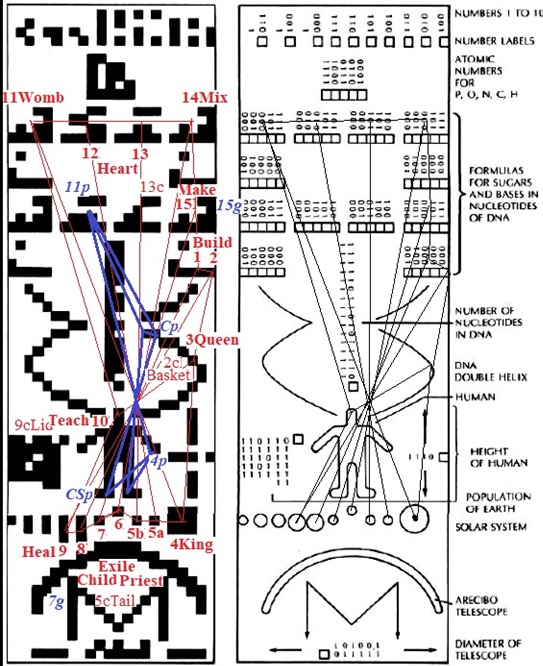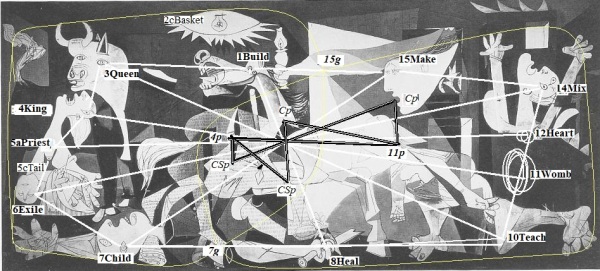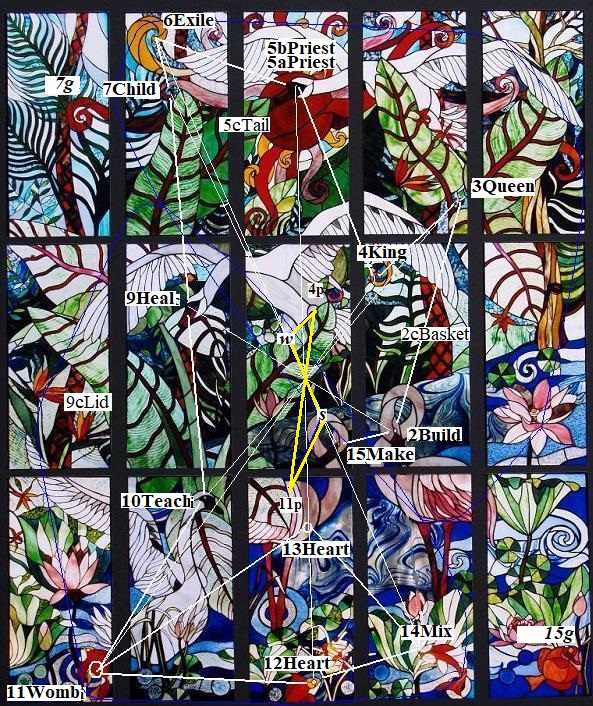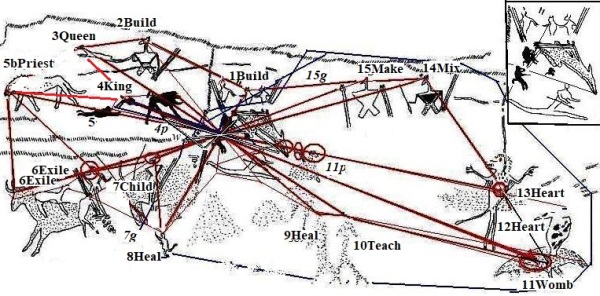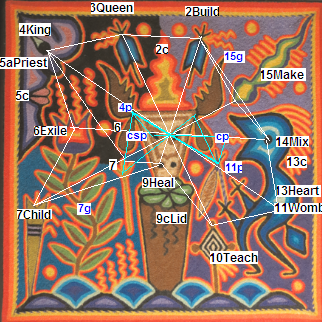The First or former Goetheanum's north green window engraving design, subconsciously expresses archetype 6, Exile or Scapegoat. Steiner’s rough sketch was detailed by Hilde Boos-Hamburger, and engraved by a team. This post identifies the subconscious archetypal cycle, and axial grid, in an engraved window. The same structure appears in all complex artworks. Steiner’s correspondence tables of seasons and classical ‘elements’ were unusual, but conscious and semi-conscious symbolic programmes seldom interfere with the subconscious structure.
Subconscious archetypes in Steiner’s Goetheanum
The Goetheanum South Blue window subconsciously expresses archetype 5 or ‘Priest’, and its decanal hour version of Aquarius. The design also expresses the usual full cycle of twelve types, independent of, and contradicting the conscious astrological symbols, as all complex artworks do.
Picasso’s Guernica as build and ruin, news and terror
Spanish Cubist artist Pablo Picasso rushed off a huge canvas themed on the Spanish Civil War and Nazi bombing atrocity at Guernica in 1937, for the Paris International Exhibition the same year. He loaned the work to a New York museum, providing that it be sent to Spain after democracy returned. Only in 1981 did the canvas go to Madrid, where it hangs in its own hall. The event remain infamous partly due to the most famous WWII theme painting. The artist subconsciously included the five layers of archetypal structure, as all artists, builders, and mythographers of all places and times do. This post demonstrates that the ‘grammar’ of meaning itself knows no exception between masters, gifted novices, rock artists, or cultural media.
Archetypes in Fassler’s tropical stained glass window for Kebble
Stephanie Fassler's tropical themed stained-glass window staircase façade for a Brett Kebble mansion in Johannesburg, has only nine living characters. The artist subconsciously used two sun ray spirals, and two fern tendron spirals, as ‘characters’. This kind of structuralist compromise is typical in minimalist artworks.
Giraffe X People, Lion People, Baboon People in rock art
Structuralist art analyses reveal the holographic or unified meanings inherent in inspiration and expression, and illustrate how artworks express meanings analogous to certain themes in myth, ritual, calendar and emblems. Art does not duplicate or arise from any other media. Every cultural medium is an independent, perpetual (never original) expression of the underlying structure of meaning that underpins matter and mind. Here is an example of Giraffe X People, Lion People, and Baboon People in a rock art panel.
Mexican Huicol peyote art also expresses revelation
Some psychologists see trance hallucinations as having ”relatively autonomous self-organisation," and as “the very first origins of art”. But Mexican Huicol healing art that supposedly demonstrates 'culture from drugs', also subconsciously expresses about 54% of the known optional recurrent or archetypal features and spacing, or mindprint structure (Furter 2014), as all complex artworks do worldwide. The structuralist anthropology model resolves disputes about the supposed ‘origin, development, evolution’ diffusion and changes’ in art. Culture is an extension of nature.
Artist Will Teather mixes ‘real’ masks and ‘unreal’ types
Will Teather’s portrait of a woman and array of clown masks in Great Yarmouth Hippodrome, questions perception and reality. Structuralist analysis reveals the standard compulsive subconscious typology and axial grid, including obscured and implied features, such as the two body types, 11 and 12/13, outside the frame. Anthropology classifies cultural features as ‘real or unreal’ by whether an artist and viewers could verbalise the same meanings. Few features in any medium are ‘real’. Nature and culture sustain a large repertoire of innate meanings, and five layers of structure, that users are unaware of.
Rock art Coat People and Bee People riddle
'Kaross' Coat People could be Bee People laden with pollen, as in the Biblical Samson’s riddle, or brood. This motif in art and rock art tends to involve a carcass, spring, potency, and ropes, known in archaeology as Sky Rope or Rain Rope People. Christmas Shelter in the Drakensberg has these semi-conscious symbolic, ritual, mythic and visionary features, as well as the usual five layers of subconscious structure. See the list of half-human and half-shape kinds of 'people' below.
Seven Greek philosophers mosaic confirms archetype in miniature art
Minimalist artworks or small iconic sets, of fewer than twelve, often express flawed mindprints by using items or limb-joints instead of eyes, and combining some axes. Even the flaws in the subconscious structure of small artefacts follow certain innate and thus archetypal ‘rules’. Archetype asserts and sustains itself in culture, via subconscious inspiration that compels artists, builders, mythographers and iconographers to complete the set of optional features, their sequence, the axial grid, and central features completing a cosmogram, irrespective of conscious intentions.
